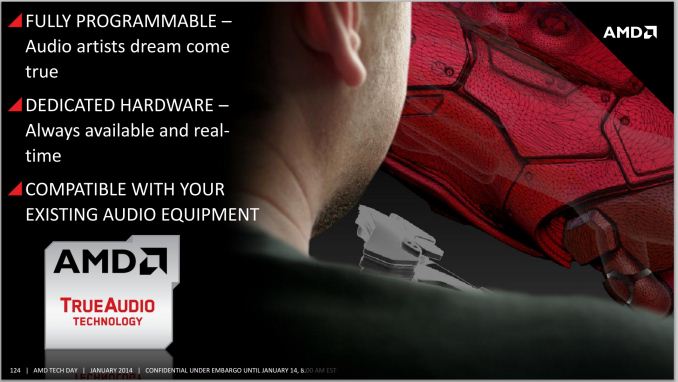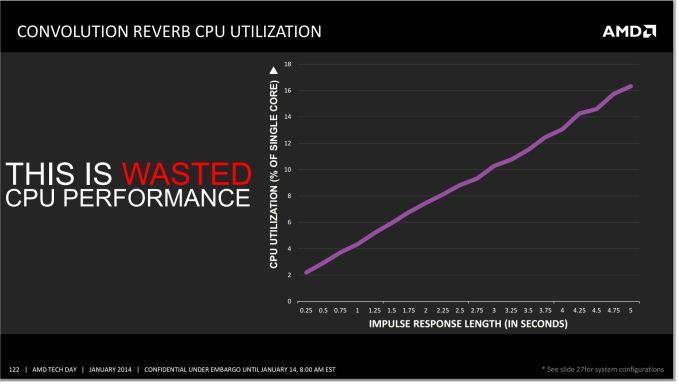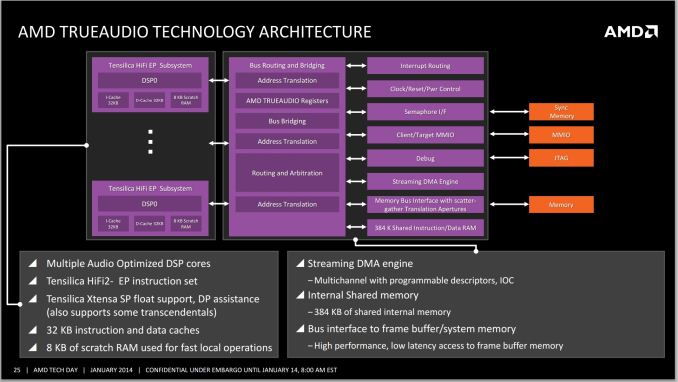AMD Kaveri Review: A8-7600 and A10-7850K Tested
by Ian Cutress & Rahul Garg on January 14, 2014 8:00 AM ESTTrueAudio
As part of the Kaveri package, AMD is also focusing on adding and updating their fixed function units / accelerators. Due to the jump on the GPU side to GCN we now have the TrueAudio DSP to allow developers to increase the audio capabilities in game, and both the Video Codec Engine (VCE) and Unified Video Decoder (UVD) have been updated.
All the major GPU manufacturers on the desktop side (AMD, NVIDIA, Intel) are pushing new technologies to help improve the experience of owning one of their products. There are clearly many ways to approach this – gaming, compute, content consumption, low power, high performance and so on. This is why we have seen feature like FreeSync, G-Sync, QuickSync, OpenCL adoption and the like become part of the fold in terms of these graphics solutions.
AMD’s new feature is TrueAudio - a fully programmable dedicated hardware element to offload audio tasks to.
The main problem with developing new tools comes down to whether they should be implemented in a general fashion or with a dedicated element. This comes down to the distinction of having a CPU or an ASIC do the work – if the type of work is specific and never changes, then an ASIC makes sense due to its small size, low power overhead and high throughput. A CPU wins out when the work is not clearly defined and it might change, so it opens up the realm of flexibility in exchange for performance per watt.
CPUs are now significantly powerful that a range of audio based techniques are available to them and the algorithms are optimized. The only limitation in this regard is the imagination of the developer or audio artist, which actually becomes part of the problem. When implementing an audio filter on the fly to a video game, the processing via the CPU can be overly taxing, especially when the effect is persistent over a long time. The example AMD gave in their press slide deck is one of adding reverb to an audio sample. The longer the reverb, the bigger the draw on CPU resources:
AMD cites this CPU usage as the effect of one filter on one audio sample. Imagine being in a firefight situation in a video game, whereby there are many people running around with multiple gunshots, splatter audio and explosions occurring. Implementing effects on all, and then transposing audio location to the position of the character is actually computationally expensive, all for the sake of realism. This is where the TrueAudio unit comes into play – the purpose is to offload all of this onto a dedicated bit of silicon that has the pathways built in for quicker calculations.
TrueAudio is also implemented on AMD's latest-generation R9 260 and R9 290 video cards – basically anything at least GCN 1.1 and up. Meanwhile we also know that the PS4’s audio DSP is based on TrueAudio, though given the insular nature of console development it's not clear whether the APIs are also the same on both platforms. AMD for their part is working with major audio middleware plugins (wwise, Bink) in order to help develop the TrueAudio ecosystem, so even in the case where the APIs are dissimilar, middleware developers can abstract that and focus on the similarities in the hardware underneath.
As is usually the case for these additional hardware features, games will need to specifically be coded to use TrueAudio, and as such the benefits of TrueAudio will be game specific. At the same time there are not any games currently on the market that can take advantage of the feature, so the hardware is arriving before there is software ready to use it. The first three games on AMD's list that will support TrueAudio are Murdered: Soul Suspect, Thief, and Lichdom. Much like FreeSync, I expect the proof is in the pudding and we will have to wait to see how it can affect the immersion factor of these titles.
Unified Video Decoder and Video Codec Engine
I wanted to include some talk about the UVD and VCE with Kaveri as both are updated – we get UVD 4, an update to error resiliency for H.264, and VCE 2, as shown below:
Of the two blocks, the improved VCE has the more interesting improvements to discuss. With the addition of support for B frames in H.264 encoding, the resulting ability to do backwards frame prediction should help improve the resulting image quality from VCE and/or reduce the required bitrates for any given quality level. Meanwhile the addition of support for the higher quality YUV444 color space in the H.264 encoder should help with the compression of primarily linear lineart/text, which in turn is important for the clarity of wireless displays.





















380 Comments
View All Comments
Fox5 - Tuesday, January 14, 2014 - link
Where are the Iris Pro results in CLBenchmark? Where are the CPU results of CLBenchmark; is the GPU faster than Haswell's AVX2? Where's the rest of the compute benchmarks, the area that Kaveri is supposed to shine in?JDG1980 - Tuesday, January 14, 2014 - link
Incidentally, will HTPC be covered in a different review? MadVR could be a good use case for Kaveri, as it requires quite a bit of shader power but isn't that memory bandwidth intensive.beomagi - Tuesday, January 14, 2014 - link
Per charts, Why are 100W APUs slower in 1280x1024 than at higher resolutions??beomagi - Tuesday, January 14, 2014 - link
Also, 45W APUs are faster? Are the benchmarks different? The charts only mention resolution.beomagi - Tuesday, January 14, 2014 - link
Nevermind - I now see this is as a percent difference compared to the slower chip - the title said FPS and that threw me off.Ignore! :D
Dribble - Tuesday, January 14, 2014 - link
Call me cynical but it's just the same as the previous gen. If you want a small form factor extreme budget gaming box these will be pretty good. For the rest of the world if you don't care about games you'd do better going Intel, and if you do intel + a proper graphics card.As with previous gen it comes with a load of marketing slide advantages, which if previous gen are anything to go by will come to nothing - I don't see the current range of AMD machines blowing away intel machines with opencl/stream/fusion/whatever - and that was what was on the previous set of marketing slides.
I always thought their best bet was mobile - but these days that markets getting really tough now for AMD as Intel have just spent the last few years optimising power usage.
UtilityMax - Tuesday, January 14, 2014 - link
The biggest elephant in the room is that very few average people (those who don't visit this web site) care for playing games on laptops (or even desktops, considering the consoles). Once you ignore the gaming performance, the A10 APU effectively has the performance of Core i3, but at a high price. A Fry's or Best Buy "special" laptop with Core i3 can cost as low as $400 or less. But the A10 laptops cost around $500. Intel's pricing is pretty aggressive on the low end IMHO.jimjamjamie - Thursday, January 16, 2014 - link
Not just in laptops, the price/performance ratio of the dual-core Pentiums is extremely good - the Haswell-based Pentium G3220 (3GHz dual core, 3.5MB cache) is available in the UK for just over £40, which is excellent value.Nagorak - Wednesday, January 15, 2014 - link
Yes, the issue is that the hybridization of CPU/GPU really provides no advantages. For someone actually playing games the GPU is still too weak and they'd be better off with a discrete card. For someone not playing games the quality of the integrated GPU doesn't matter.Maybe I'm wrong and there are tons of people out there playing games at ~30 FPS with low settings. I just don't see why someone who wants to play games wouldn't try to cough up an extra $100 for a discrete GPU, and if you don't play games then even Intel's older HD GPUs are fine.
mikato - Wednesday, January 15, 2014 - link
*For someone actually playing [newer 3D intensive] games the GPU is still too weak and they'd be better off with a discrete card. Yep*For someone actually playing [older or lighter] games the GPU is good enough and you end up with a cheaper overall package without needing a discrete card.
*For someone not playing games, they will benefit big time from HSA eventually. Not there yet and depends on the software.
There are probably more people in the last two categories if you think about it. AMD isn't for us gamers right now unfortunately. And it's going to take a while for adoption for HSA to bring in the third category of people.